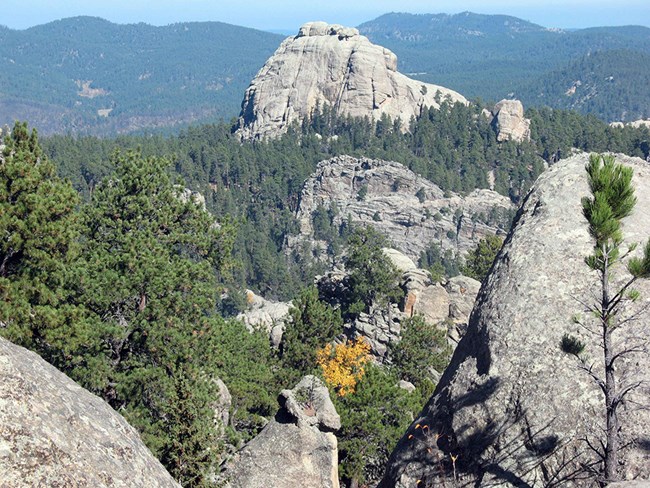
NPS Photo Soils vary based on properties of the parent material or bedrock, elevation and climate. The parent material for soils in the central Black Hills is generally granite or mica schist. Granite is very hard and breaks down slowly. Mica schist is a softer metamorphic rock that breaks down more readily and creates well-drained soils. This type of soil is ideal for ponderosa seedlings. In many areas, the bedrock beneath the soil is deeply fractured. Joints and fissures in this rock fill with water that has passed through the soil, and are an important source of water for ponderosa pine root systems.
While parent material gives soil its original properties, climate and plant life can also influence it. The climate of the Black Hills is cold and dry. In such a climate dead plant material, or detritus, decomposes slowly and nutrients take longer to return to the soil. Pine needles with their thick, waxy coating take even longer to break down and can accumulate to form a thick layer on the soil. When rain and melting snow pass through this layer of detritus it forms humic acid and slightly raises the soil pH. Minerals, particularly aluminum and iron, are removed from the soil by growing ponderosa pines, making the soil more and more acidic over time. The acidic soil prevents understory plants from getting a start. Young ponderosa seedlings are able to tolerate the acidic soil and to outcompete other plant life.
One organism that thrives in the acidic soil is a fungus that forms vast networks of branching hyphae. Hyphae are hair like filaments that release enzymes in the soil that aid the process of decomposition. In typically dry ponderosa forest soils the fungi parasitize tree roots to acquire more nutrients. The trees in return receive additional moisture from the extended "reach" of the fungi's hyphae. This is a symbiotic relationship where both members of the relationship benefit. The acidic soils of the Black Hills prove to be an ideal foundation for the plant and animal communities that live in and above its surface.
|
Last updated: January 23, 2023
